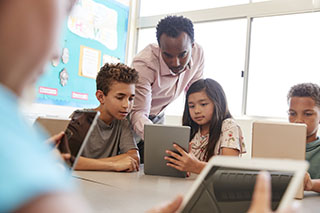1/22/2023
Expanding Digital Equity Means More Than 1:1 Devices
For more than 25 years, educators have sought to provide students with technology tools, skills, and support as part of their learning journey. This is particularly true now, as schools and districts provided mobile devices and internet access to every student for remote learning during the pandemic. While increasing access to technology increases the amount of time students spend on screens, it also supports more differentiated instruction and more actionable data for teachers.
For students who have been historically and systematically underserved, digital equity is more complex than providing devices, platforms, and training. Expanding digital equity requires that we consider technological, instructional, and cultural accessibility, and that we:
- Leverage students’ strengths and effectively scaffold instruction
- Encourage students to use digital tools to collaborate, create, and solve problems
- Share diverse curricula that include all learners’ cultures and engage their interest
Students who have traditionally not had access to devices and internet at home are now exposed to new opportunities because of the abundance of technology. Getting SMART notes that, “Outside of school, particularly when students may not be able to participate in other enrichment activities, digital technologies can help to connect them with peers, explore different interests, and engage in different creative endeavors.”
Impact and Use of Digital Devices
Most schools and districts now have mobile devices available for students to use both in school and at home. However, this doesn’t mean students should spend all their time on these devices.
According to Robyn Rausch, licensed professional counseling supervisor and registered play therapist, “The impact of the screen is that the lighting and rapid display of visual and auditory stimulation dysregulates the nervous system.” This can lead to emotional sadness and sleep disruption, among other issues, so it is recommended that teachers and parents monitor for excessive use.
Even though teachers and students are back in the physical classroom, many teachers have continued to use some elements of remote teaching—such as the flipped classroom model, where students watch videos at home to prepare for class and then have active-learning activities during class time. Many teachers have found the flipped classroom model an effective way to maximize face-to-face instructional time.
Effective learning is often a mix of online and face-to-face instruction, with as much active learning as possible.
Balancing School and Home Screen Time
With the impact of excessive screen time in mind, educators must be intentional about how they incorporate devices into their lesson plans—for instance, by using blended learning, which mixes teacher-led instruction with online practice. This learning model uses technology in the way it is most effective and allows educators to limit the amount of time students spend on screens during the school day. A meta-analysis of children’s screen time published in JAMA Pediatrics found that regardless of quality, increased screen time is linked to lower language development.
At home, parents can reduce the amount of time their children spend on screens by encouraging other activities, such as sports or playing outside, creating art, playing board games, and listening to music. Rauch advises, “Teach kids about how screens make our brains and bodies tired and stressed. If you have the chance, suggest that kids be outside for at least an hour before they have any screen time.” Much of the harm done from too much screen time can be remedied with unstructured free time and access to nature, Rausch added.
While it is important that every student has access to the same resources and instruction, equality (treating every learner the same, without regard to their different needs) is not sufficient. Instead, equity—evaluating the needs and gaps of individual students and providing them with the instruction, scaffolding, and tools they need—will help students prepare for their futures.
EducationWeek's tip sheet on how to manage students’ screen time is available for download.

